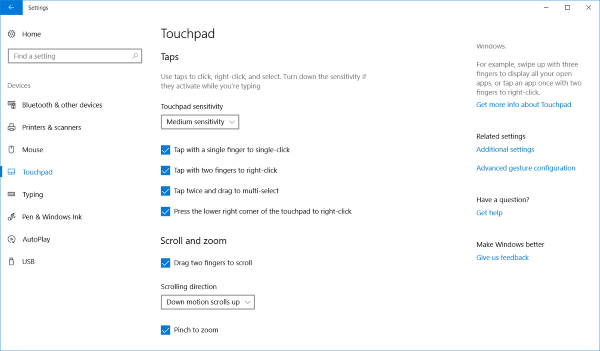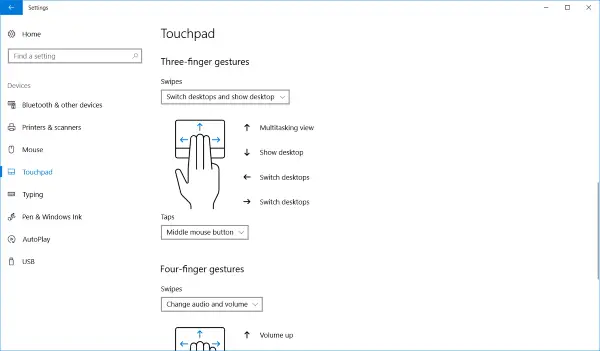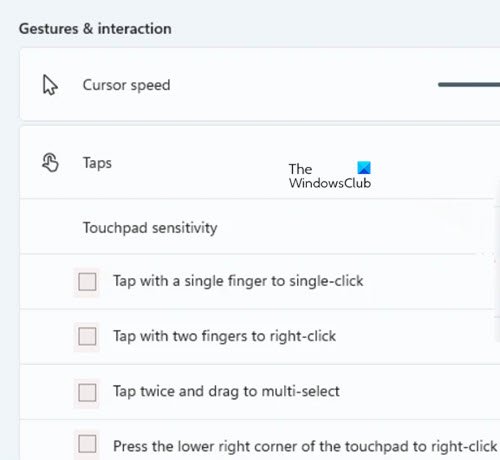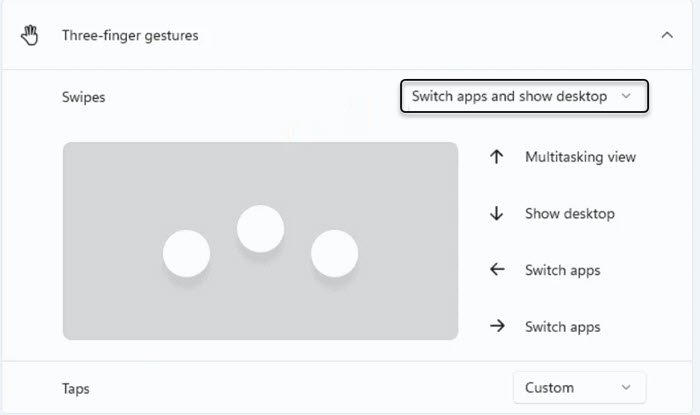Modern computing has definitely shifted from using a mouse to touch-based devices like touchscreens and touchpads. Windows welcomed ‘Precision Touchpad’ which is nothing but a fancy name for better touchpads. Precision Touchpads are better in all kinds of performance. They are more accurate and support a lot more gestures than your normal everyday touchpads.
If you have recently purchased a laptop, most likely it should have a Precision Touchpad. Windows 11/10 offers great customizability and it comes with all new gestures that are supported by Precision Touchpads.
Precision Touchpad settings in Windows 11/10
This post discusses the features offered by these touchpads and how to configure relevant gestures. We have discussed Windows 10 first, followed by Windows 11.
Windows 10
To get started, first you need to check whether your device has a Precision Touchpad or not. Go to Settings and then into Devices, now select Touchpad from the left menu.
Now just below the main ‘Touchpad’ heading, you will find a line saying, ‘Your PC has a precision touchpad.’
If you do not find this line, then probably your PC does not come with a precision touchpad or you do not have the proper drivers installed. Check your manufacturer’s website for the latest drivers. You can also try replacing the default drivers with some other drivers that support these features, but please carry it out at your own risk and with proper precautions.
If you do not have the Precision Touchpad, you might not be able to use certain features discussed in this post.
With Precision Touchpads, there are the following gestures available which are discussed in detail as follows:
Taps

This section enables gestures like ‘Tap with two fingers to right-click’, ‘Tap twice and drag for multi-select’ and ‘Press the lower right corner of the touchpad to right-click’. You can control the touchpad tapping sensitivity and enable/disable all these gestures in this section.
Scroll and Pinch to Zoom
This section is most helpful and important as some users consider it difficult to scroll using a touchpad. Under this section, you can enable ‘Drag two fingers to scroll’ which is a much-needed feature. Moreover, you can invert the scrolling direction with respect to the above gesture. And finally, you can enable ‘Pinch to Zoom’ under this section. ‘Pinch to Zoom’ lets you use a familiar touchscreen based gesture on the touchpad.
Read: Touchpad getting disabled automatically.
Three-finger and Four-finger gestures
These are probably the best gestures you can use. They include swipes and taps. Both Swipes and Taps have a predefined domain from which you can choose the desired action. You can use them for multitasking or for controlling the audio and volume of your device. I prefer using Three-finger gestures for multitasking and Four-finger gestures for media control. These gestures can also be disabled completely.

Similarly, for taps, you can assign an action for a list of available actions. You can ‘Search with Cortana’, mimic ‘Middle Mouse Button’, ‘Play/Pause’ content, open ‘Action Center’, or just set it to do nothing. I’ve been using three-finger tap to mimic the middle mouse button and four-finger gesture to play/pause videos and other content.
Windows 11
You can use the following gestures to start with Precision Touchpads in Windows 11.
First, right-click the Start button on the Taskbar and choose settings from the list of options displayed therein. Alternatively, you can use Win+I keyboard shortcut to go to the settings window directly.
Next, select Bluetooth & devices from the side panel on the left.
Switch to the right pane and scroll down to the Touchpad heading.
Then, do the following.
For Taps

Under the Taps heading of the Touchpad’s Gestures & interaction section, you can configure the following actions.
- Tap with a single finger to single click.
- Tap with 2 fingers to right-click.
- Tap twice to drag and multi-select, etc.
Similarly, you can place two fingers on the screen and slide horizontally or vertically to scroll it. Likewise, you pinch in or stretch out the screen by placing two fingers and dragging it inwards or outwards.
For Three-finger and Four-finger gestures

You can use 3 and 4 finger gestures to multitask. For example,
- Swipe the screen with three fingers up to show all the open windows.
- Swipe with three fingers down on the screen to show the desktop.
- Swipe with three fingers to the left or right on the screen to switch to the last open app.
- Swipe with four fingers to the left or right on the screen to switch desktops.
What is precision Touchpad support?
In the simplest language, precision touchpad support is the support for touchpad gestures in Windows. It performs the same function as the mouse on a Desktop computer and also offers the ability to assign custom shortcuts to various mouse gestures.
Read: List of Touch Screen and Touchpad Gestures in Windows 11
How do I make my Touchpad more accurate?

Adjusting its sensitivity can make your Touchpad more accurate. To do so, go to Settings > Bluetooth & devices > Touchpad.
Click Taps drop-down menu to adjust the sensitivity.
These are the Precision Touchpad Gestures Settings in Windows 11/10. We expect more customizability in the future with more types of actions available. Surely, these gestures improve the overall user experience and make it simpler to perform some actions. But remember that Precision Touchpads have been introduced recently so there might be a possibility that your device does not come with one.